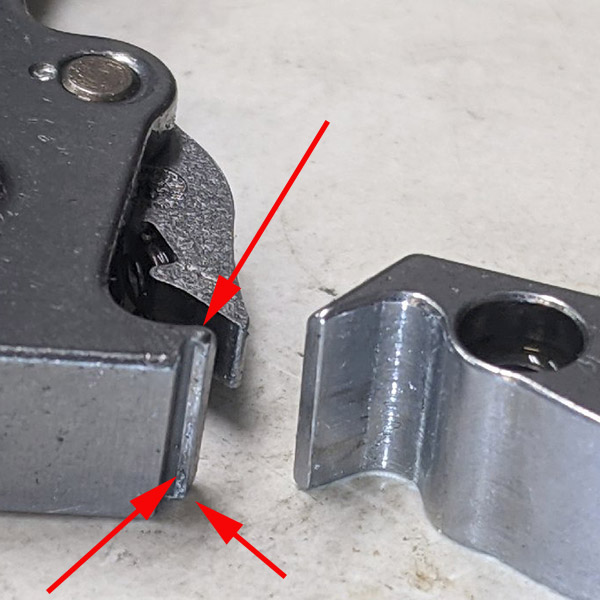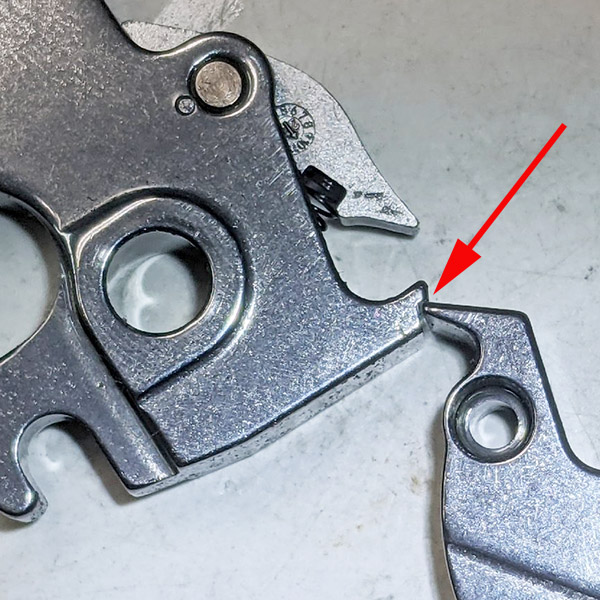My new Python trigger, although smooth it's horrifically heavy.
Curious if anyone else found this to be the case.
Reading and talking to people about how incredible the Python action is I expected more.
Maybe some got lucky, or some never had a quality revolver or never a any gun to compare.
I have my share of revolvers, rifles, autos and the like, factory stock and action jobs.
This gun is beautifully crafted with exceptionally polished harden stainless steel fire control parts.
It is a smooth pull, but does have D/A stacking, albeit slight, but its there.
Yes, it's a production gun, but I would think it would be better than my 629 out of the box.
After some investigation it's the California's politicians fault for the excessive positive hammer hook shelf angle.
This angle actually forces the trigger sear nose into the back hammer shelf, the more foward pressure on the hammer the more it wants to keep the trigger sear nose captive.
Great for safety of hammer push off and the great Cali drop test on concrete 6 times without hammer fall, which is kind of pointless with a transfer bar.
So when you pull the S/A trigger the hammer actually is forced backwards first before dropping.
Not ideal for me at the extreme positive angle it's cut at, which seems to be around 4 degrees.
What I did to make it more better.
After stoning the ramp down to about a 1 degree to neutral angle on the hammer hook shelf, its now almost perfect.
I didn't want to go into a negative angle, so maybe a lighter spring to get it closer to 2.5lbs next, or if I can find a new V spring to play with, I may experiment with narrowing.
Not hard to do, and knocked off a pound which made a considerable difference.
Before;
6lbs S/A
10lbs 2oz D/A
After;
5lbs S/A
9lbs 8oz D/A
It's a great gun, but with a little work it's even better.
My new 2021 Anaconda exhibits the same deal.
![Image]()
Sent from my SM-G892A using Tapatalk
Curious if anyone else found this to be the case.
Reading and talking to people about how incredible the Python action is I expected more.
Maybe some got lucky, or some never had a quality revolver or never a any gun to compare.
I have my share of revolvers, rifles, autos and the like, factory stock and action jobs.
This gun is beautifully crafted with exceptionally polished harden stainless steel fire control parts.
It is a smooth pull, but does have D/A stacking, albeit slight, but its there.
Yes, it's a production gun, but I would think it would be better than my 629 out of the box.
After some investigation it's the California's politicians fault for the excessive positive hammer hook shelf angle.
This angle actually forces the trigger sear nose into the back hammer shelf, the more foward pressure on the hammer the more it wants to keep the trigger sear nose captive.
Great for safety of hammer push off and the great Cali drop test on concrete 6 times without hammer fall, which is kind of pointless with a transfer bar.
So when you pull the S/A trigger the hammer actually is forced backwards first before dropping.
Not ideal for me at the extreme positive angle it's cut at, which seems to be around 4 degrees.
What I did to make it more better.
After stoning the ramp down to about a 1 degree to neutral angle on the hammer hook shelf, its now almost perfect.
I didn't want to go into a negative angle, so maybe a lighter spring to get it closer to 2.5lbs next, or if I can find a new V spring to play with, I may experiment with narrowing.
Not hard to do, and knocked off a pound which made a considerable difference.
Before;
6lbs S/A
10lbs 2oz D/A
After;
5lbs S/A
9lbs 8oz D/A
It's a great gun, but with a little work it's even better.
My new 2021 Anaconda exhibits the same deal.

Sent from my SM-G892A using Tapatalk







